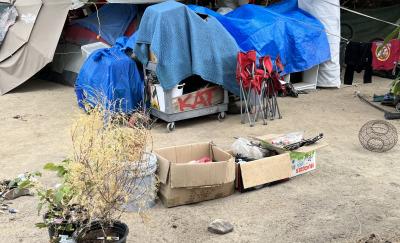Why We Should Be Talking about Rapid Re-housing When We Talk About Guaranteed Income


Guaranteed income (GI) is a rapidly growing approach to helping address systemic economic inequities, offering cash with no strings attached to eligible participants. As program designers and advocates develop GI, they can learn a lot from rapid re-housing (RRH) programs—a housing assistance model that provides short-term assistance to support housing stability. Likewise, RRH can learn from GI, with its emphasis on trusting participants to make the best choices for themselves and their families.
GI programs provide recurring cash payments with no strings attached directly to individuals who meet certain eligibility criteria. Participants have the flexibility and freedom to determine how to use their cash. GI has gained attention in recent years; in the U.S. alone, there are currently more than 100 GI pilot programs offering participants anywhere from $375 to over $1,000 per month for one to three years. Most pilots pay a fixed amount monthly, though a few offer a lump sum up front to help participants with big expenses like car repairs or up-front costs to lease an apartment; one program offered participants a choice of payment structures.
RRH connects individuals and families experiencing homelessness to permanent housing quickly through short-term cash payments to private landlords, with the goal of helping them to stabilize there. RRH programs typically provide rental assistance in one of three formats: (1) a security deposit, first month’s rent, and move-in assistance; (2) fixed short-term rental assistance, where the program pays a set amount of the household’s rent for a certain number of months; and (3) tapered rental assistance, where the household receives 100 percent of their rent and the subsidy is decreased over a set amount of time. RRH also provides case management focused on helping people afford housing on their own when their rent subsidy ends. A case manager can help individuals and families connect with financial counseling, health care services, job readiness and employment services, life skills training, and more. Some RRH programs provide additional selected supports to families—like grocery gift cards and transportation assistance—to help households cover needs while they stabilize.
1. What do RRH and GI programs have in common?
A few key similarities between GI and RRH make comparison between the two useful. For example, both programs are time limited, an important commonality that distinguishes them from many other safety net programs. The Housing Choice Voucher (HCV) and Supplemental Nutrition Assistance (SNAP) programs, for example—continue as long as the household’s income qualifies them. Both HCV and SNAP follow a “gap” formula in which maximum benefit is reduced by a percentage of the participant’s income. This design creates a disincentive (found by research to be quite small) to increase income, because every additional dollar of earnings is “taxed” by the program. In some cases, participants may face a “benefits cliff” as they approach the program’s income limit. RRH and GI programs—such as the pilots underway now—face different, interrelated questions, namely:
- How long should participants receive financial assistance?
- How do they fare when financial assistance ends?
- How long do any gains resulting from the cash assistance last?
(Importantly, if GI programs were not time limited, they would have to face benefits cliff issues.)


RRH, like the current round of GI pilots, scaled up quickly in response to a national crisis. Beginning in the 1990s, communities piloted programs that offered short-term rental subsidies to help families avoid long stays in shelters and move into permanent housing quicky. RRH received a major infusion of funds under the 2009 American Recovery and Revitalization Act (ARRA), with community-level variability in how to design and implement the program one of its distinguishing features (Khadduri, Dunton, and Brown, 2020). While GI experiments date back at least half a century in the U.S., the current wave started with the Stockton Economic Empowerment Demonstration (SEED) in 2019, growing to more than 100 pilots in under four years, in large part in response to the COVID-19 pandemic and sometimes making use of American Rescue Plan (ARP) funds.
For both approaches, their rapid scale-up has meant there is a lot of community-by-community variation in who they serve and how, rather than all programs following a more uniform design. Across the country, RRH is a key housing assistance program, serving a range of households, including individuals and families who are not able to afford housing after a recent economic setback as well as participants who use RRH as a bridge to a long-term housing subsidy. As we have described in previous work, these different housing trajectories mean that RRH can either be a temporary reprieve or set a household onto a trajectory for sustained stability (Jefferson, et al., 2020).
Similarly, GI pilots serve a wide range of participants, with variation in how much cash they receive, for how long, and to what end. For crisis-related assistance, such as managing the COVID lockdown or temporary increases in gas prices, time-limited GI eased a temporary increase in household costs. Chelsea Eats is one example of a GI program oriented toward temporary increases in expenses. Other GI pilots think about cash as a path toward economic mobility, while yet others are providing cash to households who are deeply impoverished and for whom a temporary GI may only provide temporary reprieve. GI advocates may choose to move toward targeting a narrower range of households for whom a few years of unrestricted cash can likely make a transformative difference. Or they may follow the path of RRH’s development, continuing to embrace local variation in the design of programs.
2. What could GI programs learn from RRH?
RRH programs have staff focused on helping households identify, secure, and maintain stable housing. These staff can help link households to other programs and supports as needed, though we have found that participants often value the emotional support and life coaching more than programmatic referrals (Jefferson et al., 2020). While offering cash-only assistance is one approach to use in GI pilots or programs, designers may want to explore making life coaches or service navigators available to participants to help them pursue their self-defined goals. Should GI programs decide to pursue this strategy, participation in the coaching should be voluntary and participant driven.
After rental assistance ends, many RRH programs provide case management to help participants with any immediate setbacks. Often this support is focused on maintaining their housing, but sometimes it includes other types of support or connections to other service providers. GI pilots have taken different approaches to offboarding participants, often with fewer wraparound support because of their emphasis on cash as the intervention rather than services. Offboarding ranges from simple notification to planning workshops, such as applying to—or reconnecting with—other assistance programs after leaving the program, or financial coaching, so participants can adjust to losing the assistance without it being a financial shock. As GI programs develop, there may be more conversation about how to ease the post-GI transition and for whom, without such services becoming a “string” attached to the cash; RRH programs may offer some inspiration.
3. What could RRH programs learn from GI?


In our experience, RRH programs are not as person-centered as they could be. RRH financial assistance is restricted to housing and is paid directly to the landlord, depriving households of the agency and dignity to make financial decisions for themselves. This design also means that RRH programs often are not positioned to provide various other supports that may be needed, such as employment and childcare (Jefferson et al., 2020).
Historically, many Continuums of Care (CoCs), through their coordinated entry systems, prioritized individuals and families for RRH program participation by using the Vulnerability Index-Service Prioritization Decision Assistance Tool (VI-SPDAT) tool. Research has shown that this tool, which considers a person’s overall vulnerability, often gives lower prioritization scores to BIPOC people and prioritizes white people for permanent supportive housing at higher rates than BIPOC individuals. Currently, many RRH programs are re-examining screening and assessment processes to adopt a more equity-focused approach.
GI pilots have so far been designed in explicitly equity-conscious ways, tailoring their eligibility criteria to target people who have been systematically excluded from the social safety net due to racism, sexism, and other structural barriers. By offering unrestricted and unconditional cash, GI programs operate with a trust-forward ethic that centers participants’ agency and decision-making. Households have complex needs (e.g., health, employment, transportation, and childcare challenges) that are unpredictable, fluid, and often beyond the scope of what traditional RRH programs can provide. Unrestricted cash payments like those offered through GI programs could resolve some challenges that RRH programs other federal funds typically cannot cover. And trusting participants to make those decisions for themselves has inherent value.
What insights and questions do you have about GI and RRH? Let us know!
Read More

Association for Public Policy Analysis & Management (APPAM) 2024 Fall Research Conference
Experts from Abt Global will be presenting at the Association for Public Policy Analysis & Management (APPAM) 2024 Fall Research Conference.

Understanding Homeless Encampments in Long Beach, L.A. River Basin, and San Fernando Valley
A Conrad N. Hilton Foundation-funded, Abt-led evaluation studied three encampments in Los Angeles.

Rental Housing Results from Low-Income Housing Tax Credits
Abt is merging databases with information on rental housing results from low-income housing tax credits to inform decision-making.

Wyoming Turns to Abt to Create Statewide Housing Plan
The State of Wyoming has turned to Abt Global to help it rapidly and effectively address its housing shortage by creating a statewide action plan.


